

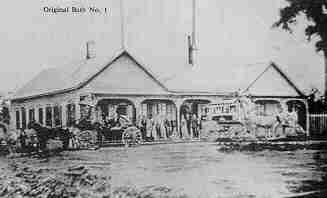
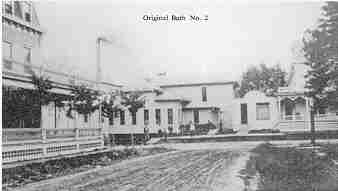
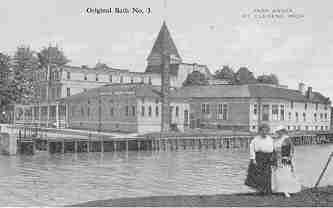

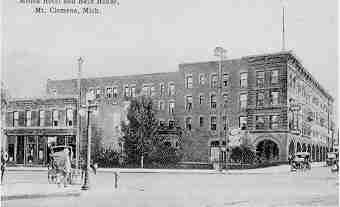
The bath section was equipped with solid porcelain tubs of large size, the bath rooms partitioned with white Italian marble, the floors of vitreous tiling, all offering a high degree of beauty and sanitation. The new bath house flourished, so in 1899 the Mount Clemens Bath Company acquired all of the property north to Court House Square and built a 150 room hotel which opened to the public on June 6, 1904. The principal stockholders were now Paul and Adam Ullrich, as well as Mr. Daley and Mr. Russell. The number of baths continued to increase, as evidenced by the number given in the month of July, rising from 4,869 in 1890 to 6,748 in 1891 and to 7,681 in 1892. The bath house was rebuilt in 1891 with 150 porcelain tubs that could accommodate 1,500 baths a day. It was pretentious for the time and was one of the largest bathing establishments in the world. The price of a mineral bath, however, was reasonable in the early days, 50 cents each and 25 cents more for the services of an attendant.
The four-story MEDEA Hotel combined several styles of architecture. Romanesque on the first level, the design included a 180 foot segmental arch with circular end arches, classic stone cornices and Gothic moldings. As described in Eldredge's Macomb Couny History (p. 126), the construction was "...of brick, stone and steel, is practically fire-proof. The ten massive arches forming the first story of the Gratiot Street frontage are of Lake Superior red sandstsone, and enclose an arcade porch one hundred eighty feet in length by sixteen feet in width. The same stone is used with red pressed brick in carrying up the entire front of this building, giving a rich and massive effect."
Three generations of the Ullrich family were associated with the MEDEA Hotel and Bath House. Paul Ullrich's son, Paul J. purchased Adam Ullrich's interest in 1902 and was to serve as manager for a long period. Matthew Slush was a stockholder at one time, but in the early 1930's the Ullrich family bought out the minority interests and became the sole owners. Marcus, John and David Ullrich, sons of Paul J. were active in the business at various times until it was sold to the Priehs Realty Company in 1955.
Unfortunately, with the decline of the bath industry, the MEDEA fell upon hard times, was poorly maintained, neglected, vandalized, and demolished in 1991. It was especially noteworthy for the long array of beautiful arches that covered a walkway along South Gratiot. With its demise, a long-time Mount Clemens landmark and the last of the downtown bath houses disappeared.

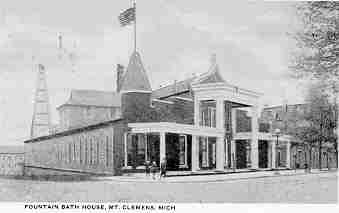
The FOUNTAIN gave special attention to ventilation and offered larger rooms and tubs for those guests so badly crippled as to have difficulty bathing in the usual tubs. A gymnasium was provided for all patrons. According to the 1904 Cutter's Guide, improvements made to the FOUNTAIN included solid porcelain tubs, tile and mosaic floors, marble wainscoting and partitions. It was the second largest in the city, having 70 bathrooms, 40 cooling rooms, ladies' and gentlemen's parlors, physician's office and a rotunda or general reception room over 20 feet wide by 56 feet long and ceilings 24 feet high. The private cooling rooms assured perfect privacy to bathers. The FOUNTAIN mineral wells were one of the deepest wells in the city and were located just back of the bath house. Their advertisement read "The price of baths is the same as at all the houses, 50 cents for mineral water, 25 cents for mineral foot bath, and 75 cents for mineral vapor. Fresh water bath 25 cents. Attendants fee 25 cents extra."
The FOUNTAIN Bath House was said to be one of the most complete and cheerful in the city, capable of bathing 500 patrons daily. A star feature of the bath house was the 40 individual cooling rooms which were in a separate hall, large and well-ventilated. A steam laundry was included, as most bath houses found it necessary to run their own laundries to wash the vast number of towels and blankets used by the bathers. The FOUNTAIN Bath House was the site of the first electric lights in the city using their own private generator in 1888. In 1913 the derrick over the mineral well collapsed into the street. Mineral water had a deteriorating effect on wood in the near vicinity. It is not known if there were any injuries.
Queen Anne porches with oriental balustrades were distinctive features of the FOUNTAIN Hotel at 124 North Gratiot. The hotel was in connection with the FOUNTAIN Bath House via a heated passageway under the Crystal House at 122 N. Gratiot, then under Clinton Street and up a stairway into the Bath House. The Clifton House, located at 56 Market Street, was also connected to the FOUNTAIN Bath House by an above ground enclosed passageway. The FOUNTAIN Hotel was the site of the first elevator in Mount Clemens. On New Year's eve in 1924, the hotel burned down in a very spectacular fire. At the time, the building was closed for the winter and there were no known injuries. The White Star Hotel next door, formerly the Crystal House, was extensively damaged.
The FOUNTAIN Bath House operated until 1938 when it closed and the building was demolished. An A&P grocery store was built there in 1939.

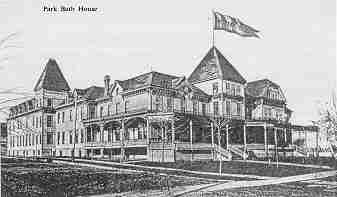
In 1887 Margretha Kieffer, from Buffalo New York, brought her ailing daughter to Mount Clemens with the hope that a course of mineral baths might bring a cure. They stayed at the Central Park Hotel at 61 East Street. The daughter passed away, but Mrs. Kieffer, a sharp business woman, chose to stay and invest in the hotel. In partnership with her son-in-law, Benjamin McArthur, they purchased the Central Park Hotel and changed its name to Park Hotel. In 1892, Margretha's husband, John, became the partner of William Burgard and together they built and operated a new bath house which was connected with the Park Hotel. A very large, 3-story, 200 room addition was completed in 1898.
The PARK Bath House and Hotel were the most expensive, with wide spacious verandas and pleasant halls, affording continuous promenades. The interior was furnished most sumptuously, with splendid lobby, wide corridors, and many rooms with private bathrooms for every comfort, convenience and luxury of the guests. The bath house and hotel were under the same roof, doing away with exposure to outside air and long tedious passageways.
It was considered one of the finest bathing institutions in the country, with marble floors, partitions, wainscoting, private cooling rooms and every latest improvement. This bath house and hotel offered a gymnasium, bowling alley, bar and card rooms in the basement, and there was an elevator for the guest's convenience. A grand eighteen foot wide hallway led from the hotel to the bath house, where, by 1928, nearly half a million mineral baths had been given.
The PARK became the social center of Mount Clemens and was the scene of many fabulous parties and balls. Known for its luxurious accommodations, the PARK hosted many affluent and famous personalities including Henry Ford, George M. Cohan, Mae West, Booth Tarkington, William Randolph Hearst, Helena Rubinstein, Jerome Kern, William Jennings Bryan, Alice Roosevelt and Fannie Hurst.
In 1911 the proprietors purchased the grounds formerly occupied by the Avery Hotel which had been destroyed by fire. It was located across the street from the hotel, between Jones and Park Street. They converted the area into a lovely picturesque park with fountains, flowers, shrubbery and paths. The park was built for the comfort and relaxation of the PARK Hotel patrons.
Benjamin McArthur passed away in 1899 and his wife Julia Kieffer McArthur assumed his interest in the hotel. John Kieffer passed away in 1900 and the bath house partnership passed to his son, George H. Keiffer. When Margretha Kieffer died in 1911, she left her interest in the PARK Hotel to her daughter Julia.
Business declined slowly after the depression of 1929. By 1937 the hotel was listed as vacant. Considered hazardous because of neglect and vandalism, the hotel was demolished in 1940. A USO Recreation Center was built there and was converted into the Mount Clemens Civic Center after World War II.

 Colonial Hotel & Bath House - includes photo!
Colonial Hotel & Bath House - includes photo!
 Olympia Hotel & Bath House - includes photo!
Olympia Hotel & Bath House - includes photo!
 St. Joseph Sanitarium - includes photo!
St. Joseph Sanitarium - includes photo!
 Take me back to the main Macomb County Page!
Take me back to the main Macomb County Page!